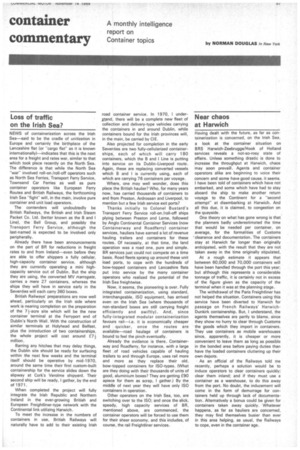Loss of traffic on the Irish Sea?
Page 59

If you've noticed an error in this article please click here to report it so we can fix it.
NEWS of containerization across the Irish Sea—said to be the cradle of unitization in Europe and certainly the birthplace of the Lancashire flat (or "cargo flat" as it is known internationally)--indicates that this is the next area for a freight and rates war, similar to that which took place recently on the North Sea. The difference is that while the North Sea "warinvolved roll-on /roll-off operators such as North Sea Ferries, Transport Ferry Service, Townsend Car Ferries as well as pure container operators like European Ferry Routes and British Railways, the forthcoming Irish Sea "fight" will, in the main, involve pure container and unit load operators.
The contenders will undoubtedly be British Railways, the British and Irish Steam Packet Co. Ltd. (better known as the B and Line), the Bell Group, and possibly the Transport Ferry Service, although the last-named is expected to be involved only peripherally.
Already there have been announcements on the part of BR for reductions in freight rates to and from Ireland—even before they are able to offer shippers a fully cellular, high-capacity container service, although they are currently operating a mini highcapacity service out of Dublin. But the ship they are using, the converted MV Harrogate, carries a mere 27 containers, whereas the ships they will have in service early in the Seventies will each carry 360 boxes.
British Railways' preparations are now well ahead, particularly on the Irish side where work is nearing completion on the preparation of the 7-1-acre site which will be the new container terminal at the Ferryport end of Dublin's North Wall. With the construction of similar terminals at Holyhead and Belfast, plus the introduction of two containerships, the whole project will cost around E71 million.
Barring any hitches that may delay things, the Dublin site should be ready for surfacing within the next few weeks and the terminal itself should be operative by mid-1970, around the same time their first custom-built containership for the service slides down the slipway at Cork's Verolme shipyard. Their second ship will be ready, I gather, by the end of 1971.
When completed the project will fully integrate the Irish Republic and Northern Ireland in the ever-growing British and European Freightliner-type network with the Continental link utilizing Harwich.
To meet the increase in the numbers of containers in use, British Railways will naturally have to add to their existing Irish road container service. In 1970, I understand, there will be a complete new fleet of collection and delivery-type vehicles carrying the containers in and around Dublin, while containers bound for the Irish provinces will, in the main, be carried by CIE.
Also projected for completion in the early Seventies are two fully-cellularized containerships, each of which will carry 180 containers, which the B and I Line is putting into service on its Dublin-Liverpool route. Again, these are replacing converted vessels which B and I is currently using, each of which are carrying 76 containers per voyage.
Where, one may well wonder, does this place the British haulier? Who, for many years now, has carried thousands of containers to and from Preston, Ardrossan and Liverpool, to mention but a few Irish service exit ports?
Thanks initially to Colonel Bustard's Transport Ferry Service roll-on /roll-off ships plying between Preston and Larne, followed by Anglo Continental Container Services now Containerway and Roadferry) container services, hauliers have earned a lot of revenue hauling trailers and containers for these routes. Of necessity, at that time, the land operation was a road one, pure and simple. BR services just could not compete on a time basis. Road fleets sprang up around these unit load ports, to cope with the hundreds of bow-topped containers and Lancashire flats put into service by the many container operators who realized the potential of the Irish Sea freightwise.
Now, it seems, the pioneering is over. Fully integrated containerization, using standard, interchangeable. ISO equipment, has arrived even on the Irish Sea (where thousands of non-standard boxes are still carrying freight efficiently and swiftly). And, since fully-integrated modular containerization favours rail—i.e. it is economically cheaper and quicker, once the routes are available—road haulage of containers is bound to feel the pinch eventually.
Already the evidence is there. Containerway and Roadferry, for instance, with a large fleet of road vehicles capable of hauling trailers to and through Europe, uses rail more and more as they replace their old, bow-topped containers for ISO-types. (What are they doing with their thousands of units of good, aluminium boxes? They are getting €90 apiece for them as scrap, I gather.) By the middle of next year they will have only ISO containers in operation.
Other operators on the Irish Sea, too, are switching over to the ISO: and once the slick, speedy, high capacity services of BR, mentioned above, are commenced, the container operators will be forced to use them for their sheer economy, and this includes, of course, the rail Freightliner services.




















































































































